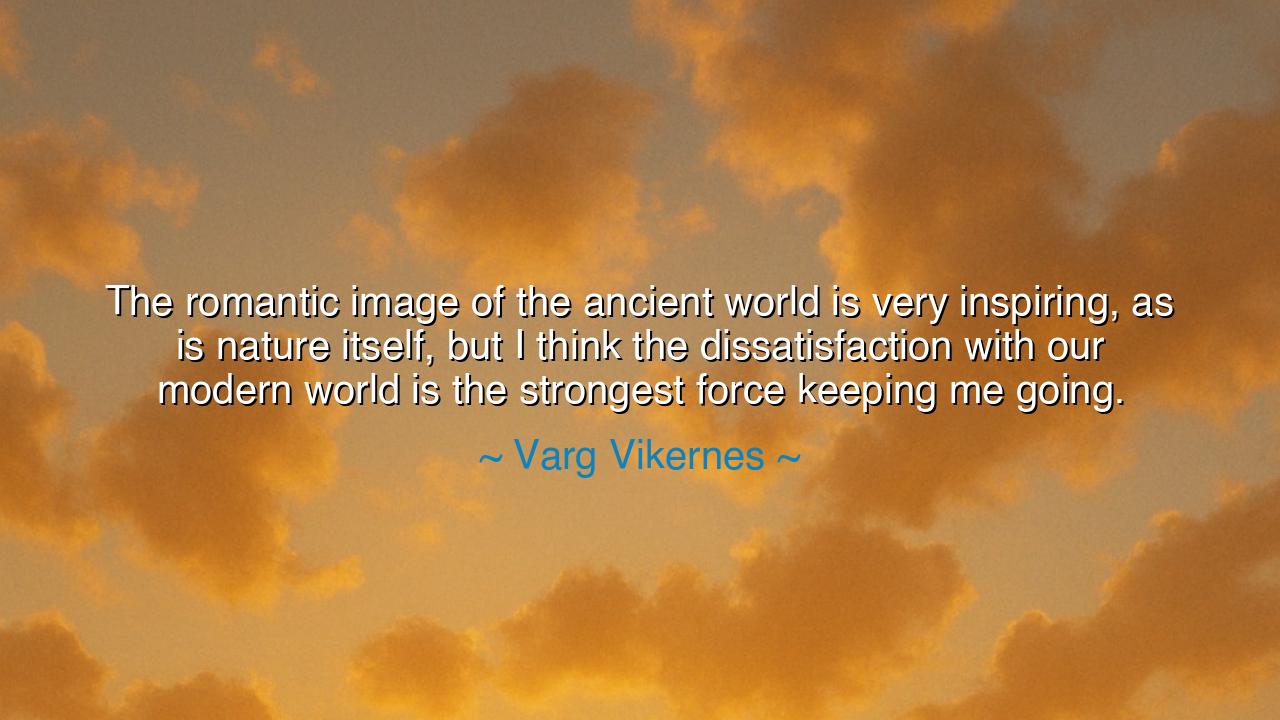
The romantic image of the ancient world is very inspiring, as is
The romantic image of the ancient world is very inspiring, as is nature itself, but I think the dissatisfaction with our modern world is the strongest force keeping me going.






"The romantic image of the ancient world is very inspiring, as is nature itself, but I think the dissatisfaction with our modern world is the strongest force keeping me going." These words, spoken by Varg Vikernes, carry a weight of deep reflection. They express a profound yearning for a time that was, in the eyes of the speaker, both pure and noble—a time when the connection to nature and the past was untainted by the complexities and dissatisfaction of the present world. It is a cry from the heart of one who feels displaced in an age where the soul is often overwhelmed by the pace of life and the artificiality of modernity.
In the ancient world, men and women lived in close harmony with nature. They sought wisdom from the stars, the rivers, and the mountains. Philosophers like Heraclitus and Socrates believed that the key to understanding the human soul lay in its relationship with the natural world. The romantic image of the past that Vikernes refers to is not just a longing for a simpler time, but for an age when the natural rhythms of the earth governed life. It is an idealized vision of a world untouched by the rush of industrialization, a time when man lived in balance with the cycles of life.
Yet, in our own time, the modern world is a world that often alienates us from these rhythms. Cities rise up like massive structures of steel and glass, disconnecting us from the earth beneath our feet. Our days are marked by the ticking of the clock, the demands of work, and the relentless noise of technology. The question arises: where is the space for reflection in such a world? Where can one find the peace that once came from sitting beneath the shade of an ancient tree or standing at the edge of a flowing river, listening to the quiet murmur of water?
This dissatisfaction with the present is not unique to Vikernes, nor to our time. The Romantic poets of the 18th and 19th centuries, such as William Wordsworth and Samuel Taylor Coleridge, too, lamented the loss of natural beauty in the face of industrialization. They saw the growing cities, the smog, and the machinery as symbols of a world that had lost its way. They sought to return to a time when the soul could find peace in the quiet of the countryside, in the wildness of nature. Their words were both a call and a warning—return to nature, or risk losing the very essence of what it means to be human.
Yet, like Vikernes, the Romantics also felt a tension. They, too, were caught in the throes of a modern world that demanded new ways of thinking and being. And so, it is that this dissatisfaction becomes the fuel for creation and action. The dissatisfaction with the present age is not merely a feeling of helplessness but a powerful force that pushes the individual to search for meaning beyond the confines of the society they inhabit. The pain of being disconnected from the past, from nature, and from the true essence of life spurs the creative spirit, driving one to seek something greater than what the world offers.
Consider the philosophers of the Stoic school, who lived during times of great political upheaval and societal disintegration. Figures like Marcus Aurelius and Seneca were keenly aware of the faults of the world around them. Yet, instead of being overwhelmed by these faults, they turned inward, finding solace not in external circumstances, but in the pursuit of virtue and wisdom. For them, the world’s failings became a challenge—a call to live in a way that transcended the chaos. Dissatisfaction, then, was not a burden, but a gift—a tool for personal growth and a reminder that the true path lies in one’s inner strength and understanding.
In our own time, we too must grapple with the tension between the past and the present. The ancient world offers wisdom, beauty, and connection to the natural world that can seem lost in the frenetic pace of modern life. However, the lesson from history, from the ancient Stoics to the Romantics, is that dissatisfaction is not the enemy. Dissatisfaction is the spark that lights the fire of change, that drives us to seek meaning, and to reconnect with the world around us. Rather than lamenting the state of the world, let us transform that dissatisfaction into action, as the ancients did. Let us seek the wisdom of the past, embrace the beauty of nature, and bring those truths into the modern world. Let us use the dissatisfaction we feel to inspire growth, to search for the eternal truths that lie buried beneath the surface of the ever-changing world around us.
In this way, dissatisfaction can become a force for good, a motivation to rediscover our roots, to find balance between the wisdom of the past and the needs of the present. Let us take from Vikernes’ words a lesson: that in the midst of discontent, we can find purpose—and from that purpose, the strength to move forward and create a world that reflects the harmony of the ancient and the modern.






AAdministratorAdministrator
Welcome, honored guests. Please leave a comment, we will respond soon